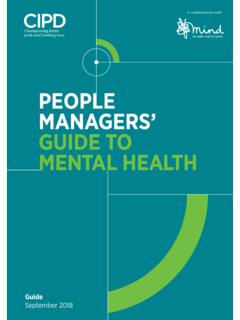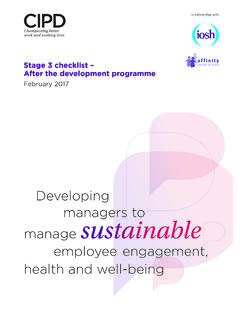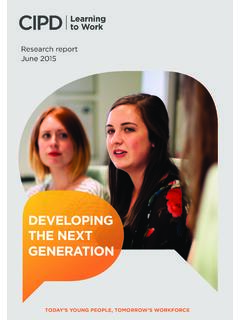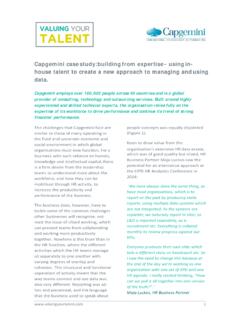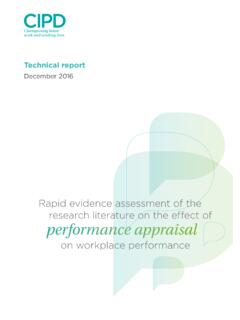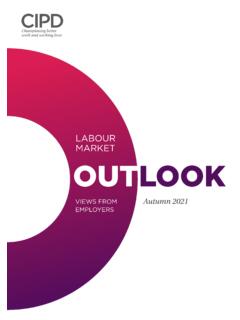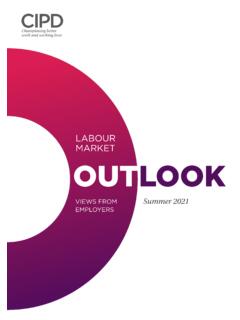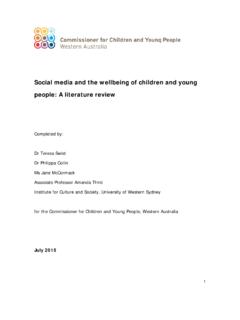Transcription of Flexible working: Lessons from the pandemic - CIPD
1 Report April 2021 From the nature of the work to the design of workFLEXIBLE working : Lessons FROM THE PANDEMICThe CIPD is the professional body for HR and people development. The registered charity champions better work and working lives and has been setting the benchmark for excellence in people and organisation development for more than 100 years. It has more than 150,000 members across the world, provides thought leadership through independent research on the world of work, and offers professional training and accreditation for those working in HR and learning and working : Lessons from the pandemicReportFlexible working : Lessons from the pandemic From the nature of the work to the design of workAcknowledgementsThis report was written by Dr Charlotte Executive summary 2 How the research was conducted 5 Flexible location: seven strategies for hybrid working 5 Flexible hours: seizing the opportunity? 20 Conclusions and recommendations 24 Further resources on Flexible working 282 Flexible working : Lessons from the pandemic1 Executive summaryThe COVID-19 pandemic has shown that, in the case of Flexible work design, the impossible turns out to be possible after all.
2 An enforced trial of homeworking has demonstrated to many managers that it works better than they could have imagined and given them the opportunity to develop their skills in making it work. Perceived barriers in the nature of the work which were said to render remote working impossible have faded away as managers have learned to design work the pandemic has enforced total, five-days-a-week homeworking, our survey revealed that, after lockdown, 63% of employers planned to introduce or expand the use of hybrid working to some degree, combining time in the workplace with time at home, depending on the needs of the job, the individual and the team, and the team working was positive news on the productivity of homeworkers too. Despite the difficulties of lockdown, more than two-thirds (71%) of survey participants said that homeworking had no detrimental impact on productivity. This figure is made up of 33% who said that productivity improved, and 38% who said it was report identifies seven strategies which teams and their managers can use to make a success of hybrid working :1 Develop the skills and culture needed for open conversations about Encourage boundary-setting and routines to improve wellbeing and prevent Ensure effective co-ordination of tasks and task-related Pay special attention to creativity, brainstorming and problem-solving Build in time, including face-to-face time, for team cohesion and organisational Facilitate networking and inter-team Organise a wider support network to compensate for the loss of informal summary33 Flexible working : Lessons from the pandemicExecutive summaryThe situation regarding Flexible hours has changed less: employers have not experienced an enforced trial of Flexible hours.
3 The wide range of sectors and types of work covered in the interviews for this research led to very different outcomes. Some interviewees did work which, when done at home, facilitated greater informal flexibility of hours giving individuals more autonomy to choose their start, finish and break times, and enabling them to mix work and personal tasks without rigid boundaries. However, others found that the work demanded hours similar to those worked in the workplace, although of course without the interviewees found that flexibility of hours was prevented by the sheer volume of work, regardless of its location. Others commented that it was harder to set work life boundaries at home, finding that they worked longer hours at home than in the and challenges of homeworkingNone of the benefits or challenges identified in our survey was mentioned by a majority of survey participants. This suggests that they are highly dependent on individual circumstances, both at home and at work.
4 A tailored approach to individual needs, and to work design, is needed to maximise the benefits and minimise the reported the key benefits and challenges of homeworking as follows:Benefits The most frequently mentioned benefit was increased wellbeing through avoiding the commute (46% of survey participants), followed by enhanced wellbeing because of greater flexibility of hours (39%). Although collaboration is often mentioned as a challenge of homeworking, survey participants reckoned that both creating new ways to collaborate with IT tools, and IT upskilling, were benefits of homeworking, at 34% and 23% respectively. A reduction in distractions also featured (33%), although given that lockdown enforced homeworking regardless of home circumstances, some employees were dealing with increased distractions. Normalising the use of technology could help inclusion for those with a disability or illness that prevented or impeded travel, and for those working in distributed teams.
5 Finally, homeworking enabled people to get to know their colleagues better as individuals, learning more about their non-work challenges of homeworking can be divided into three types: wellbeing , hygiene factors and work-related factors:1 Reduced mental wellbeing of staff due to isolation was cited as a challenge by 44% of survey Hygiene factors are those which, in a voluntary homeworking situation, would be dealt with in advance, or might preclude homeworking altogether: the unsuitability of certain jobs (36%); unsuitable home circumstances (31%); insufficient technology (15%); outdated technology (15%); and lack of staff proficiency with technology (14%).3 Among work-related factors were: difficulty with staff interaction and co-operation (26%); lack of staff engagement (19%); line manager capability to manage homeworkers (19%); and line manager capability to monitor staff performance (18%).4 Flexible working : Lessons from the pandemicExpectations of change in Flexible workingEmployers reported the following expectations of change in Flexible working : While 63% of employers in our survey said that they planned to introduce or expand the use of hybrid working to some degree, a remarkably high 45% said they planned to introduce or expand the use of total, five-days-a-week homeworking to some degree.
6 However, interviewees from operational business units were more cautious about the feasibility of total homeworking, preferring hybrid working for most teams and types of work. The most common measures planned to facilitate the expansion of homeworking were: changing policy (45%), improving technology (41% investing in the quality of technology; 35% investing in the quantity of technology) and online guidance (33%). Only 28% of respondents said they planned to put in place manager training in remote working a low figure given the challenges of work design and management identified in this report. This is discussed further in section Almost half of employers (48%) said they were planning to introduce or expand the use of flexitime (formal or informal; employer-led or employee-led) to some degree. Forty-five per cent of this group cited fairness as a reason: employees who can t work from home should still be able to benefit from other Flexible working and recommendationsThe CIPD has recently launched its #FlexFrom1st campaign calling on organisations and the Government to introduce the right to request Flexible working from day one of employment to support opportunities for all.
7 This report makes the following recommendations for policy and practice to improve Flexible working opportunities: 1 Provide training and support to enable productive homeworking. In order to achieve productive homeworking, employers need to provide training and support in hybrid working , using the seven strategies identified in this report and our guides. Our findings suggest caution in the use of total, five-days-a-week homeworking: wellbeing , productivity and learning could all suffer without much more extensive manager training and change in working practices. Despite 63% of employers saying that they will introduce or expand the use of hybrid working , only 28% have plans to train managers in how to manage Proactively explore flexibility of hours. Employers need to be more proactive about flexibility of hours, particularly for those workers whose jobs don t lend themselves to flexibility of location. Job tasks need to be analysed for hours flexibility as well as location flexibility, and a more proactive, team-based approach will often yield better results than reactively waiting for individual requests for flexibility of Assess the differing business case for Flexible working in different sectors and jobs.
8 The wide range of sectors and types of work covered in this project has shown how much the business case for Flexible working can vary by sector and by type of work. Government and employers need to work together to assess the business case for Flexible working in hard-to-flex sectors and jobs, where work has not traditionally been designed for work life balance. The first step is to assess how the costs of Flexible working are currently distributed between individuals, the business unit, the organisation as a whole and the state, in different types of report is supplemented by seven organisational case studies and guides outlining practical advice for employers and line managers looking to improve their Flexible working summary55 Flexible working : Lessons from the pandemic2 How the research was conducted At the start of this project, we conducted a review of the research evidence on working from home. The research for this report then consisted of two elements, qualitative and researchFor the qualitative research, interviews with 32 senior managers and directors were conducted between October 2020 and January 2021, using insights from the evidence review.
9 Seven interviewees were people professionals, but the majority were in operational roles. This approach enabled exploration of the practical challenges of designing jobs across a range of different types of work in hospitality, construction, education, IT, professional services, telecoms and local government. Some of these sectors have historically tended more towards employer-led flexibility, which is driven by business requirements for Flexible resourcing, rather than employees need for work life worked in both large and small organisations, in the public and private sector, and were located across the UK. Some worked for employers who were in the process of introducing or updating their Flexible working initiatives and using lockdown as an opportunity to accelerate progress. Some interviewees embraced both Flexible location and Flexible hours, while others focused on homeworking. Interviewees were asked about the opportunities and challenges presented by homeworking, and how the pandemic has affected other types of flexibility.
10 Interviews were recorded, transcribed and thematically analysed. Quantitative researchThe quantitative research involved an online survey with a total sample size of 2,133 senior decision-makers in UK organisations, conducted by YouGov. Fieldwork was undertaken between 14 December 2020 and 4 January 2021. The figures have been weighted and are representative of the UK business population by size, sector, industry and Flexible location: seven strategies for hybrid working Introduction: standard and COVID-enforced homeworkingWorking from home has long been an organisational strategy for both saving the cost of office space and improving work life the lockdown resulting from the pandemic offered a unique opportunity to trial homeworking, it s nonetheless important to remember that many jobholders can t work from home health and care workers, delivery drivers, construction staff and supermarket checkout operators, for example, continued to work as s also worth remembering that there are several key differences between COVID-enforced homeworking and standard homeworking.
